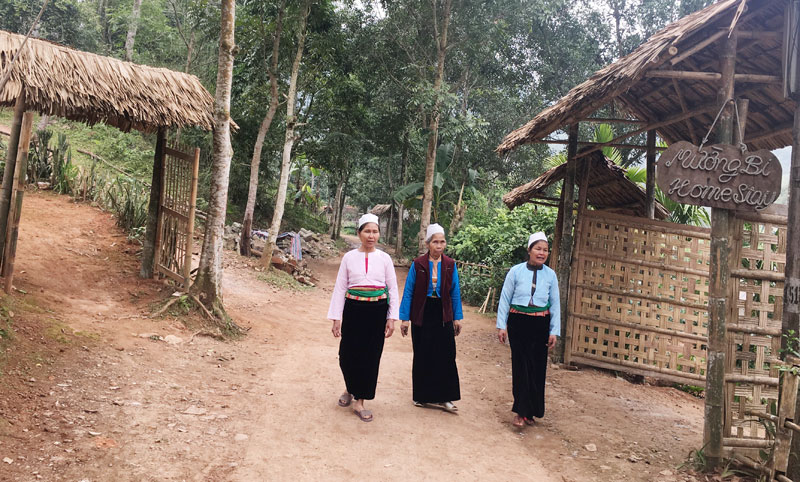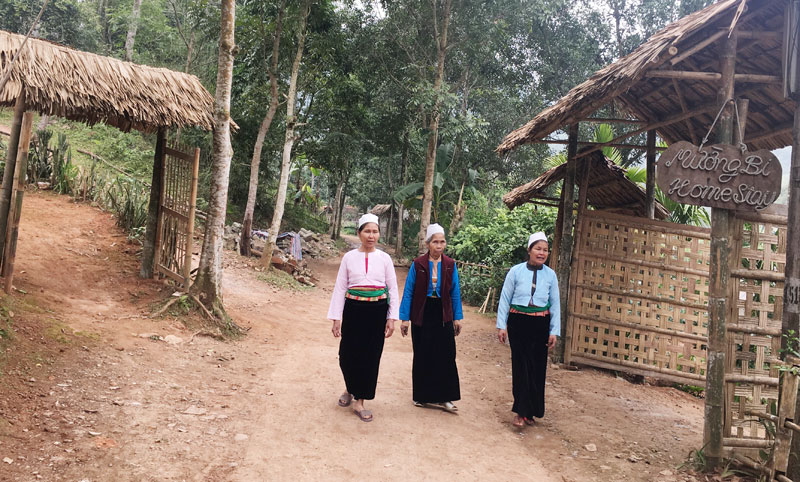


 The people in Muong Luy Ai village, Phong Phu commune (Tan
Lac) have been doing tourism in association with preserving the traditional
cultural beauty.
The people in Muong Luy Ai village, Phong Phu commune (Tan
Lac) have been doing tourism in association with preserving the traditional
cultural beauty.
The traditional festival is a place to display and help to visualize the cultural values in a realistic and lively way. Since 2000, Khai Ha Festival (Khuong Mua), the most notable and ancient traditional festival in the locality, has been restored.
Khai Ha festival is the most popular festival of the ancient Muong Bi people to pay homage to the gods and to commemorate those who have established the land and the Muong, to pray for everything to develop smoothly and to pray the prosperous crops and good things to the villagers. Taking place annually on the 7th to 8th of the lunar January in Phong Phu commune, Khai Ha Festival is a big event that Muong people always look forward to, attracting the participation of a large number of national, international tourists.
After the Khai Ha Festival, the district has restored the special traditional festivals such as fishing festival in Lo Son stream; the festival of Ke pagoda in Phu Vinh commune ... The festivals have been creating power, having strong impact on the consciousness of people in conserving and preserving the traditional cultural values and enriching the spiritual life. Consequently, the intangible cultural values of Muong gongs, Mo Muong, the folk songs, the charms, the customs, the costumes, the traditional handicraft villages ... have also been preserved and promote.
The livelihood of people in the ancient Muong village, Luy Ai, in Phong Phu commune used to be very hard and difficult. Even so, the community, the village very have unanimously been preserving the cultural beauty from the forefather's life. Here, the traditional houses have remained the architectural form of ancient stilt houses.
The eating and living habits, the customs and the habits have been maintained ... This is also the basis for Muong Ai village to be recognized as a community tourist area by the Provincial People's Committee in 2014, and it was also recognized as a typical traditional village of the ethnic minorities by the Ministry of Culture, Sports and Tourism. It was included in the project "Improving and preserving the ancient Muong villages invested by Department of Culture, Sports and Tourism. At present, Luy Ai has become a major tourist attraction in the national highway 6 and the Northwest inter-regional tourism route, which is characterized as a unique cultural product.
There have been other changes in other villages such as Ngoi village - Suoi Hoa commune, Chien village - Van Son commune, Buoi Cai village - Phu Cuong commune since doing community tourism. The people are conscious of preserving the cultural identities from the spoken words, the costumes, the customs, the habits ... to help visitors have good experiences and impressions.
Thanks to keeping the "Muong soul”, the tourism destinations of high-quality in the area have been attracting domestic and international tourists, helping to promote and create a highlight of the rural appearance and effectively exploiting the outstanding tourism products of Muong Bi , that is the community tourism, the tourism of culture and festivals.